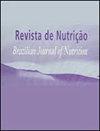Association between children and adolescents’ body composition with family income
IF 0.5
4区 医学
Q4 NUTRITION & DIETETICS
Revista De Nutricao-brazilian Journal of Nutrition
Pub Date : 2022-01-01
DOI:10.1590/1678-9865202235e200323
引用次数: 0
Abstract
ABSTRACT Objective To evaluate the association between children and adolescents’ body composition with family income. Methods Cross-sectional study, participants between 5 and 19 years were included. A standardized questionnaire assessed socioeconomic variables. The outcome variables were z-score of Body Mass Index and bioimpedance parameters (skeletal muscle mass, fat-free mass, and fat percentage) and predictor variables (age, sex, race, place of residence, father’s education, birth weight and breastfeeding) were analyzed using the quantile regression model and data from the 50th percentile are presented. The tests were bidirectional and the differences were considered significant with p<0.05. Results Among the 529 participants included, 284 (53.6%) were female and the mean age was 11.41±3.9 years. The Body Mass Index z-score was the only outcome that did not show differences between sexes (p=0.158). In the crude model, lower family income was associated with lower skeletal muscle mass (Difference=-7.70; 95% CI -9.32 to -5.89), p<0.001), lower fat-free mass (Difference= -13.40; 95% CI -16.40 to -10.39, p<0.001) and the lowest percentage of fat was associated with lower family income (Difference= -5.01, 95% CI -9.91 to -0.11, p=0.027). The z-score of BMI was not associated with family income. Conclusion Family income is directly associated with lower fat-free mass, fat percentage, and skeletal muscle mass in children and adolescents.儿童青少年身体成分与家庭收入的关系
【摘要】目的探讨儿童青少年身体成分与家庭收入的关系。方法采用横断面研究,选取年龄在5 ~ 19岁的受试者。一份标准化问卷评估了社会经济变量。结果变量为身体质量指数z分数和生物阻抗参数(骨骼肌质量、无脂质量和脂肪百分比),预测变量(年龄、性别、种族、居住地、父亲受教育程度、出生体重和母乳喂养)使用分位数回归模型进行分析,并给出第50百分位的数据。检验为双向检验,p<0.05为差异有统计学意义。结果529例患者中,女性284例(53.6%),平均年龄11.41±3.9岁。身体质量指数z得分是唯一没有显示性别差异的结果(p=0.158)。在粗模型中,较低的家庭收入与较低的骨骼肌质量相关(差异=-7.70;95% CI -9.32至-5.89),p<0.001),低脂肪质量(差异= -13.40;95% CI -16.40至-10.39,p<0.001),最低脂肪百分比与较低的家庭收入相关(差异= -5.01,95% CI -9.91至-0.11,p=0.027)。BMI的z-score与家庭收入无关。结论家庭收入与儿童青少年无脂量、脂肪率和骨骼肌量的降低有直接关系。
本文章由计算机程序翻译,如有差异,请以英文原文为准。
求助全文
约1分钟内获得全文
求助全文
来源期刊
CiteScore
1.20
自引率
12.50%
发文量
24
审稿时长
6-12 weeks
期刊介绍:
Revista de Nutrição is former Revista de Nutrição da Puccamp, founded in 1988. It is a bimonthly publication every four months and it is of responsibility of the Centro de Ciências da Vida, da Pontifícia Universidade Católica de Campinas . It publishes articles that contribute to the study of Nutrition in its many sub-areas and interfaces; and is open to contributions of the national and international scientific communities.

 求助内容:
求助内容: 应助结果提醒方式:
应助结果提醒方式:


